Subtotal: $
Checkout-

How Far Does Forgiveness Reach?
-

A Trio of Lenten Readers
-

Michael and Margaretha Sattler
-

The Blessed Woman of Nazareth
-

New Heaven, New War
-

Born to Us
-

My Fearless Future
-

Covering the Cover: School for Life
-

The Community of Education
-

Readers Respond: Issue 19
-

Family and Friends: Issue 19
-

Verena Arnold
-

Tundra Swans
-

A Debt to Education
-

What’s the Good of a School?
-

A School of One
-

On Praying for Your Children
-

The World Is Your Classroom
-

The Good Reader
-

Orchestras of Change
-

The Habit of Lack Is Hell to Break
-

Soviet Kindergarten
-

The Given Note
-

Editors’ Picks Issue 19
-

Litanies of Reclamation

Next Article:
Explore Other Articles:
Stephen Yoon is a Korean American doctor who for the last decade has cared for children with disabilities in Pyongyang, North Korea. Until last year, he lived there with his wife, Joy, and their three children as members of IGNIS Community. US government restrictions have now made it impossible for the family to return to Pyongyang.
Already a subscriber? Sign in
Try 3 months of unlimited access. Start your FREE TRIAL today. Cancel anytime.
Plough: What first inspired you to move to North Korea?
Stephen Yoon: In 2006, I attended a church meeting where a man spoke about his service work in North Korea. He had witnessed the aftermath of the famine of 1994, which had claimed the lives of three million people. Though relief supplies arrived from around the world, this man asked himself, “Would Jesus send food to North Korea, or would he actually go there?” He felt that Jesus would go to be with people and share their suffering and show them love.
I was inspired and later shared his story with my wife. We were living an ordinary life in California at the time. Joy said, “Let’s pack up and go!”
So you went …
Yes. In 2007, we moved to Rajin province, an experimental free-trade zone that borders China and Russia. I worked in a clinic. Since North Korea is a socialist country, almost every aspect of life is related to the government. We interacted with government officials within our designated departments on a daily basis.
What were some of your day-to-day challenges?
As foreigners and US citizens we faced more restrictions over what we were allowed to do without a government escort. Arranging our schedule was challenging since IGNIS Community’s eight-member team in Pyongyang shared one vehicle and one official who was responsible for the work schedule. Our team also lived together in one house because of the lack of housing for foreigners. These dynamics can be challenging.
Despite the restrictions, we were amazed by what we had freedom to do. Our daily work involved interacting with regular people in a local hospital. We treated patients and educated doctors. As long as we allowed enough time to receive the proper permission, we found there was little we could not do.
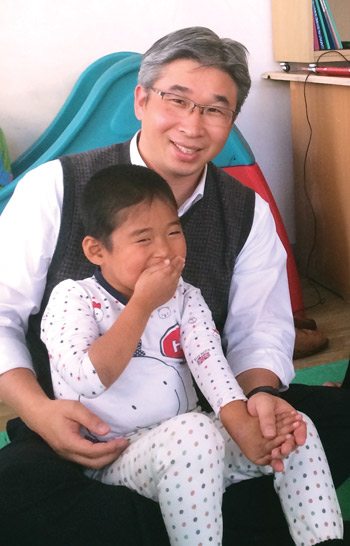
Therapy for a child with cerebral palsy
How did your community in North Korea form?
When Joy and I visited Jesus Abbey, a community in the mountains of northeastern South Korea, we were shocked to see all the different people living together, and all the problems they brought with them. Seeing how these problems could be solved gave us hope and formed the model for our developing ministry, named IGNIS Community.
Our current community includes over forty people working on a variety of projects in North Korea. Some are full members; others come for one-year or six-month internships, helping with projects. There are members from many nations. Some are health care workers, some are kindergarten staff, some are aid workers.
We made it clear to the North Korean government that we were coming as Christians to help North Korea, and this was permitted and acknowledged. Still, we are not permitted to distribute religious material or speak about our faith.
A few years ago, within a relatively brief period, several of my coworkers experienced life-threatening events. Then Joy was diagnosed with kidney cancer and returned to the United States after major surgery. Thankfully, she recovered, but I was shaken. Until then I’d been very focused on my work, but I finally realized that work is not the most important thing.
I looked at John 16: “If you love one another, the world will know that you are my disciples.” Learning how to live together in love and care for one another like brothers and sisters became central to my life. Now I see this – and not work – as my main calling.
How does your faith inform your vocation?
As a student in South Korea, I was poor at math. I felt called to serve in medicine, but becoming a doctor seemed impossible. Still, I thought, “God makes impossible things possible.” I knew what I was called to do, and I was given the faith that it could happen.
One of my patients in Rajin was unable to move her hands. I laid my hands on her, and, amazingly, she got better. After that, “incurable” patients began flocking to the clinic. This experience made me realize I should not rely upon my own strength but on God’s power.
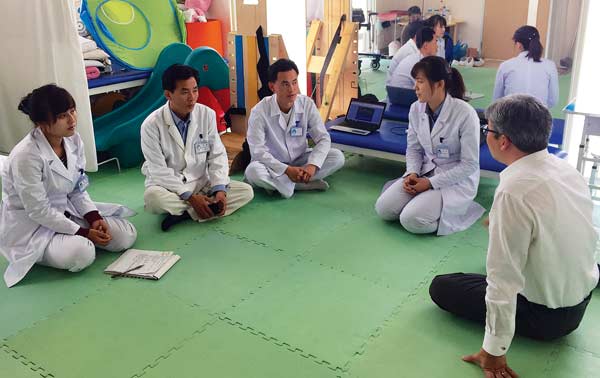
Stephen Yoon coaches doctors in the Pyongyang Medical School Hospital.
How did you become involved with patients with cerebral palsy and autism spectrum disorder?
News of my work in Rajin spread to Pyongyang, and the medical school contacted me. They told me that if I got a degree from Kim Il Sung University, my work would be better accepted. So in 2011, I became the first foreigner to receive a doctorate in rehabilitation from Pyongyang Medical School.
Then in January 2012, I met a five-year-old with cerebral palsy in Rajin. Bok Shin was paraplegic and could not swallow, so her grandmother chewed food for her and put it in her mouth. I tried to take care of Bok Shin with love. Soon she began to move her fingers.
That same year, Pyongyang Medical School invited me to teach, but I was worried Bok Shin would die if I left. I asked if she could be moved from Rajin to Pyongyang Children’s Hospital. The head of the hospital was surprised when I told him what Bok Shin’s condition was. He said there were no patients with cerebral palsy in North Korea. I just asked for Bok Shin to be given a bed, which she received.
When I began taking care of Bok Shin in Pyongyang, the parents of other patients remembered children in their neighborhoods with similar symptoms. Word spread. From all over North Korea, parents brought their children with disabilities to Pyongyang. The hospital staff didn’t know what to do with all of them. I began providing therapy there, in collaboration with the medical school.
That October, I started working with another paraplegic child, Oo-Ein. When I asked her what she wished for most, she said, “To walk to school with my friends.” Her teacher had been carrying her to school on her back. After a year of intense therapy, Oo-Ein walked out of the hospital. I said to her, “What is your dream now?”
She answered, “To become a doctor like you when I grow up, so that I can help kids like me.” The hospital staff was moved to tears.
The government reacted very favorably to this story, and Chairman Kim Jong-Un decided that doctors should be educated to treat people with disabilities and sent across North Korea to treat children. So I began working with Pyongyang Medical School to develop a curriculum to teach North Korean doctors how to treat cerebral palsy and autism. Three doctors have been trained and sent to other hospitals, and I trained four recent residents in pediatric rehabilitation.
After we received permission to train doctors in pediatric rehab, we were introduced to an American physical therapist who began visiting North Korea and treating children with autism. Before June 2015, there was no diagnosis or therapy of any kind available for children with Autism Spectrum Disorder in North Korea. Children with ASD and their parents struggled to cope with the challenges that faced them. Now over thirty doctors from Pyongyang Medical School Hospital, Pyongyang Children’s Hospital, and the DPRK Disability Federation have taken part in a lecture series on autism, and families with children who have autism are receiving treatment for the first time.
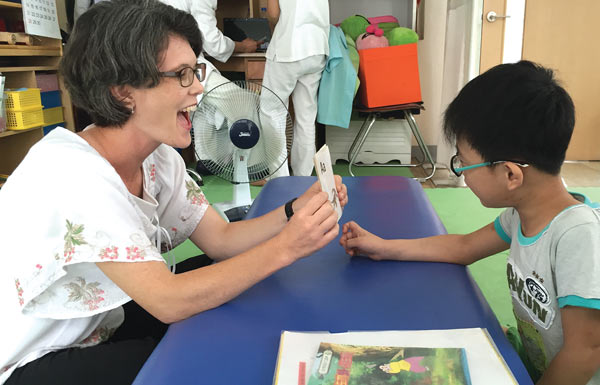
Joy Yoon instructs a child with cerebral palsy.
What has changed over this past year for your ministry as the Geographic Travel Restriction has been put into place?
In July 2017 the US State Department issued a Geographic Travel Restriction (GTR) for North Korea, which has greatly impacted both our family and our work. This change came in direct response to Otto Warmbier’s detainment and death.
However, Otto’s situation is the exception to life as a foreigner in North Korea. Approximately two hundred US citizens have been working and living in North Korea over the past few decades. Throughout these years only a handful have been detained.
Now, due to political tensions, our personal family situation, although not tragic, is disappointing. We have been traveling from country to country since the beginning of September 2018 because we do not have residence visas for any Asian country besides North Korea, and we do not currently have a home in the United States.
Our desire is to return to Pyongyang as a family. Unfortunately, the US State Department has granted only adults on our project Special Validation Passports to travel to North Korea. They have informed us that minors will not be issued special passports to travel to North Korea.
Our children are grieved by this situation. We have invested many years in our work and life in North Korea. It is a shame to lose all that we have worked so hard for. Until the travel ban is lifted we will be unable to return to full-time work in North Korea.
What is the future focus for IGNIS Community?
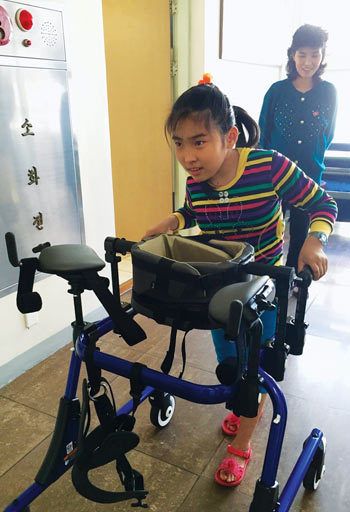
A child learns how to walk using a gait trainer donated by the Bruderhof, the community behind Plough.
The direction of IGNIS Community has not changed. We remain undeterred to share love with the people of North Korea. It is our calling to live among the people, demonstrate our love for them by building relationships with them, and develop sustainable solutions to social needs.
Since US citizens are now only able to enter North Korea on an extremely limited basis, our American team members are focused on developing leaders from other countries and supporting, from outside North Korea, the work that continues on the inside.
What advice do you have for those who want to help people in North Korea?
We believe that meaningful engagement in North Korea makes a positive difference. Our medical, humanitarian, and development work not only helps the most vulnerable of its society and changes people’s perspectives on life, but also bridges the gap between our countries.
Prayer and advocacy are needed to bring peace to the Korean Peninsula. Please join us in praying for peace between the United States and North Korea. Our work is incredibly complex as we now have to deal with US and UN sanctions, the GTR, and the visa complexities for traveling in all countries involved.
Please pray for foreign Christians living and working inside North Korea. It is not easy living in an isolated and constrained environment, so we often feel overwhelmed and discouraged. Pray that we will have the endurance and fortitude to follow through with our calling.
Finally, please pray for the treatment and acceptance of children with disabilities in North Korea. We are dedicated to establishing the first-ever treatment center for children with cerebral palsy and autism, but our work is far from done.
This interview was conducted by Sung Hoon Park in April 2016 and October 2018. Joy’s book, Discovering Joy: Ten Years in North Korea (Klug, 2018), details her family’s experiences. joyinnorthkorea.com. To learn more about IGNIS Community visit igniscommunity.org.
Photographs courtesy of Stephen Yoon and IGNIS Community
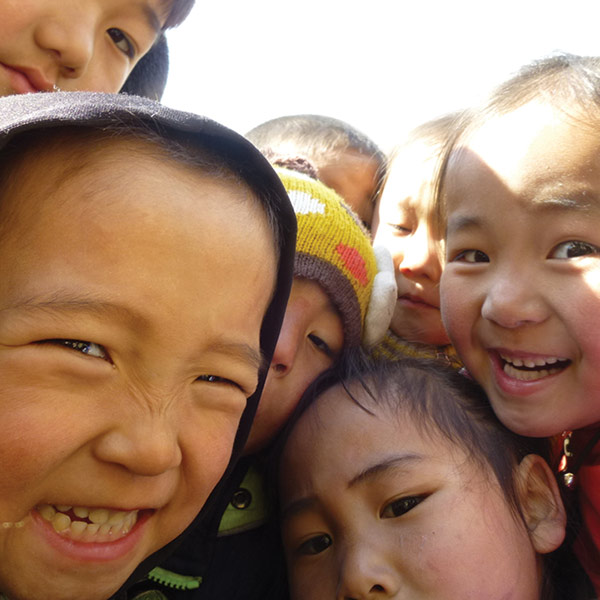 Children at a kindergarten in North Korea
Children at a kindergarten in North Korea
Already a subscriber? Sign in
Try 3 months of unlimited access. Start your FREE TRIAL today. Cancel anytime.



































Gary Whelan
Could you please state the numbers of children with Autism in North Korea?
Stewart Patrick
Wonderful testimony to God's work in His unique way in this nation. My weakness for His strength, every time. Amen!